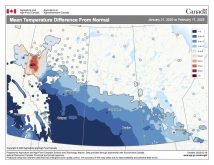As we slowly make our way into 2012 I thought we should take a little bit of time to look back at how 2011 turned out globally. I’ve already mentioned that in the last half of 2011 our region of the world saw record-warm temperatures along with very dry conditions. Globally, 2011 came in tied with 1997 as the Earth’s 11th warmest year since reliable record-keeping began in 1880, according to the U.S. National Oceanic and Atmospheric Administration’s (NOAA) National Climate Data Center. NASA, meanwhile, rated 2011 as the ninth warmest on land and the eighth warmest over the oceans. If we look only at the high latitudes (those regions above 64 degrees N), 2011 was the warmest year ever recorded. While we were dry during the second half of 2011, the world as a whole saw the second-wettest year on record, beaten only by 2010.
Read Also

June brings drought relief to western Prairies
Farmers on the Canadian Prairies saw more rain in June than they did earlier in the 2025 growing season
If we look at the all-time extreme heat and cold records set across the globe in 2011, we would find that there were eight all-time records for extreme heat and only one record for all-time extreme cold. Zambia recorded an all-time record high of 42.8 C on Oct. 26, which interestingly came only four months after that same country set an all-time extreme cold record of -9 C. This all-time cold record was the first time this type of record has been broken since 2009.
Last year saw a fairly strong La Niña event over the Pacific Ocean. This event brings large amounts of cold water to the surface of the ocean (remember, the Pacific Ocean covers about half the surface of the Earth). This cold water helps to cool global temperatures by around 0.2 C. So the fact that 2011 turned out to be so warm is a little surprising. Looking back at previous La Niña years, 2011 turned out to be the warmest La Niña year ever recorded.
Now, there has been a bunch of talk lately about natural causes that are contributing to these warm temperatures. A recent study by U.S. analyst Grant Foster and Stefan Rahmstorf of Germany’s Potsdam Institute, titled Global Temperature Evolution 1979-2010, took a look at five major global temperature data sets and then tried to adjust them to account for the three main natural drivers of global temperatures: El Niño/La Niña, volcanic dust, and changes in sunlight. They found that while these features can have year-to-year effects on temperatures, they had little to no effect on global temperatures over the long term. That is, natural causes of global warming had little to do with the observed increase in global temperatures over the last 33 years. So they concluded that the observed global warming is the result of human activity, some unknown natural source, or some combination of the two.
Education needed
Could there be some unknown natural cause for the current warming we have been experiencing? The simple answer is that there could be. Ideas like a decrease in cloud producing cosmic rays, or that the increase in carbon dioxide will help produce more clouds, which will in turn reduce the effects of the heat-trapping gas, have been bantered around, but currently publishing climate scientists don’t support these theories. There is also a lot of talk in the media and by the public in general that there is no consent among climate scientists as to the impact human activity is having on our climate. In a poll conducted in 2008, around 97 per cent of actively publishing climate scientists answered “yes” to the question, “Do you think human activity is a significant contributing factor in changing mean global temperatures?”
For the public to fully understand what is going on, a couple of things have to happen. First, we need to continue to educate everyone about the weather and climate. As most of us know, if you do not have the knowledge to fully understand a topic, it becomes easy for others to use disinformation to try to cast doubt on it. This method of trying to mislead the public was first used by the tobacco industry starting back in the 1960s to try to keep the public smoking by questioning the research linking smoking to health problems. This worked so well that we see this same strategy being used today with global warming. Now, I’m not saying that we shouldn’t have scientists who are skeptical and try to challenge the current thinking. After all, that is how the scientific process works. We can’t, though, just sit back and wait while different ideas are tossed out about global warming that may or may not dramatically change our current understanding of the Earth and the climate system. After all, dramatic changes like this don’t happen very often.
I am going to end this issue’s article with a quote from Dr. Ricky Rood. As he puts it, “Given that greenhouse gases are well known to hold energy close to the Earth, those who deny a human-caused impact on weather need to pose a viable mechanism of how the Earth can hold in more energy and the weather not be changed. Think about it.”



















